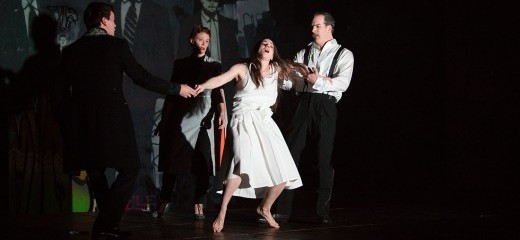
Hamlet--To Dance or Not To Dance, A Question
by Jonathan Stein
Shakespeare’s Hamlet can be heady, focused on psychological states of mind and the spoken word. The emotive and thinking body may be relegated to the role of simply coming along for the ride.Although the psychological struggles are riveting within Hamlet and his family of royals, there is so much else going on in Denmark. Something is rotten, indeed. Time is out of joint (to Hamlet, his father’s regicide two months earlier is but two hours ago). The country “is a prison, one of the worst.” The political chaos, societal corruption, surveillance, murder and incest that Shakespeare conjures into the mix need correlatives that take us beyond talking heads. The Wilma Theater currently offers us an innovative and often startling production whose dynamic use of all the elements of theater, especially the actors’ bodies, produces a memorable Hamlet.
Director Blanka Zizka’s production reflects a complex of emotions and politics, from the supernatural to the surreal expressionist. The play begins with one stark, profiled figure, Bernardo, fixed in shadowed silence. His isolation and opening line, “Who’s there?” embodies the primal fear shaping the drama. Chiaroscuro lighting, which becomes a leitmotif, reveals first Bernardo’s and his compatriots’ cowering bodies, and then the steadily pacing, columnar presence of the Ghost (Hamlet’s father, the murdered King). Grasping a large sword as an avenging crucifix in front of his body, the Ghost, mouth open wide in astonishment, moves directly toward us through center stage, extending his supernatural world into the audience.
As Ophelia (Sarah Gliko) reveals Hamlet’s infatuation to her father Polonious, her words are reimagined through movement (“He took me by the wrist and held me hard;/Then goes he to the length of all his arm”). She recites her description of a love that is only seen through such second person accounts while performing a slowly revolving, single arm counter-balance with Polonious (Joe Guzman). It is rich with implications of her being on the edge of love’s abandoned flight, as well as still in co-dependence with a willful, manipulating father. Later when Hamlet turns on her (“Get thee to a nunnery…”), she recounts her rejection in an arc of trust falls backwards into the arms of Claudius, Gertrude and Polonious. Later, after her father’s unintentional slaying by Hamlet, in her madness scene she sings her lament as she also counterbalances and trust falls. Although these movements continue a theme of her dependencies and dissolution, they may also be too undifferentiated from the prior scenes to mark her extreme of madness manifested in her words and presence, barefoot and with hair asunder.
The dance-like movements in this Hamlet derive from improvisations originating in training that Zizka and the actors, with dramaturg Walter Bilderback, have been doing in recent years with Jean-Rene Toussaint, the French-born creator of a vocal technique for “accessing the primitive voice,” and Theodoros Terzopoulis, the Greek theater director and founder of Attis-Theater in Athens. Both, influenced by Grotowski, concentrate on movement motivated from the breath and not from psychological origins.
Hamlet, the existential soloist of the drama is played by the outstanding Zainab Jah, from the U.K. and Sierra Leone. A dark-skinned woman of compact, muscular build whose race and gender together reimagine the play and its tradition, Jah is clothed in a sleek black costume that allows us to see her entire body and the strength from which she generates Hamlet’s lines. She is rarely at rest, as when we initially spy her, and at her death, both framed downstage right in an old armchair surrounded by books, under a bare bulb, an intellectual’s fraying throne. Eschewing a doleful portrayal of a Hamlet frozen by indecision and conscience, Jah traverses the breadth of the stage’s space and projects her physicality whether in sarcastic jesting with members of the court or within her own soliloquies. At times I thought I heard her breathing accentuated perhaps to mark her rising agitation and arc as the avenging son of the slain king.
Other scenes stood out as when Rosencrantz (Keith Conallen) and Guildenstern (Jered McLenigan) made individual tumbling entrances from upstage, two vaudevillian clowns, hooded as if abducted to Elsinore, who introduce us to their bumbling dissembling as spies upon Hamlet. In another scene, the Gravedigger (played by Lindsay Smiling, also the Ghost) hums the tune of St. James’ Infirmary as he shovels out dirt cast onto a stage that is already an extended graveyard of strewn dirt penetrated by swords as grave markers.
Hamlet, The Wilma Theater, April 26 to May 2, extended run, www.wilmatheater.org
By Jonathan Stein
April 22, 2015

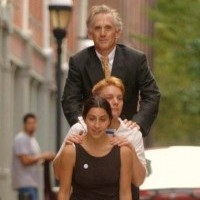
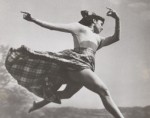
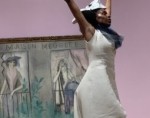
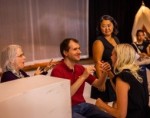

.png)


